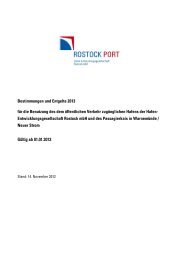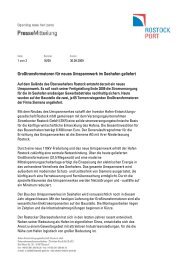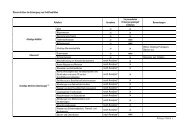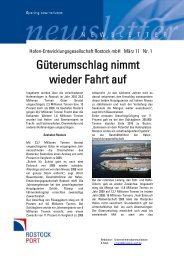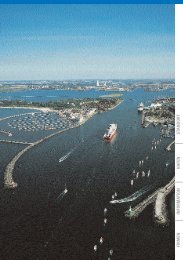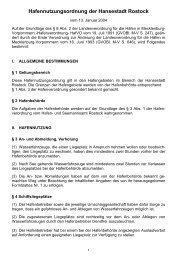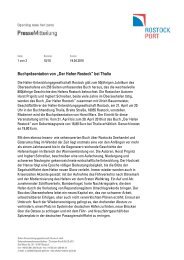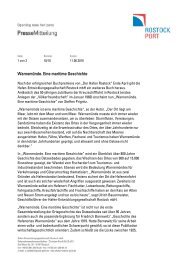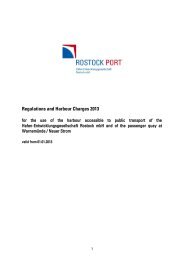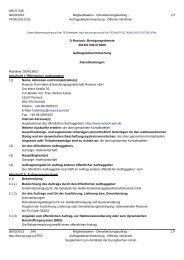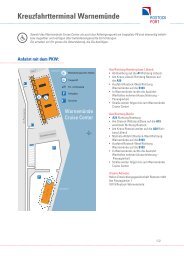Hafen Titel - Rostock Port
Hafen Titel - Rostock Port
Hafen Titel - Rostock Port
You also want an ePaper? Increase the reach of your titles
YUMPU automatically turns print PDFs into web optimized ePapers that Google loves.
STANDORT | LOCATION<br />
In the Middle Ages the port on river Warnow<br />
was one of the most important places of<br />
transshipment at the Baltic sea. A proud fleet<br />
with the <strong>Rostock</strong> griffon on the bow engaged<br />
in trade with Scandinavia, the Baltic states,<br />
western and southern Europe. The heyday<br />
of the Hanseatic League was followed by<br />
centuries of ups and downs.<br />
In the late 19th century and subsequent<br />
decades <strong>Rostock</strong> and its city harbour lost<br />
touch with the burgeoning German economy.<br />
Until 1945 the port of <strong>Rostock</strong> was only of<br />
local significance and then it lost even that<br />
as a result of the war.<br />
In post-war years the port was rebuilt. The<br />
growth of the East German economy and the<br />
creation of a large state-owned merchant<br />
fleet called for the construction of a new,<br />
efficient deep-sea port, which was commissioned<br />
in 1960.<br />
Constantly expanded and adjusted to the<br />
requirements of the GDR economy the<br />
overseas port achieved its top result in 1989<br />
at over twenty million tonnes of cargo<br />
handled, most of it dry bulk.<br />
German unification marked the beginning of<br />
the arduous effort to restructure the port,<br />
designed to suit only the requirements of the<br />
GDR, to enable it to find an acceptable place<br />
among the ensemble of German ports.<br />
In the past decades the port has profoundly<br />
changed its look and its service offer.<br />
With a modern oil port, facilities for the<br />
handling of grain, coal, fertilizer and cement,<br />
with terminals for the handling of building<br />
materials and break bulk it is still a universal<br />
place of transshipment. But its heart now is in<br />
the ferry port with the adjacent terminals for<br />
ro-ro and intermodal transport.<br />
The favourable situation of <strong>Rostock</strong> in terms<br />
of traffic geography, its easy accessibility by<br />
land and sea and enormous investments in<br />
infrastructure have made the port on river<br />
Warnow the major universal port on the<br />
German Baltic Sea coast. Since the year 2000<br />
the port has also more and more become an<br />
important industrial location.<br />
In ferry passenger traffic between Scandi -<br />
navia, Finland and Germany <strong>Rostock</strong> has been<br />
the number one for years.<br />
Just like ferry traffic, the cruise liner business<br />
too began on a very low level after 1990.<br />
Today the cruise port of <strong>Rostock</strong> in<br />
Warnemünde is the most popular German<br />
port for the giants of the seas.<br />
Hundreds of thousands of tourists, mostly<br />
from overseas, set out from here to visit<br />
the German capital Berlin and the beauties<br />
of the coastal region of Mecklenburg-<br />
Vorpommern.<br />
10–11



